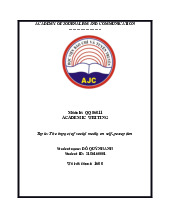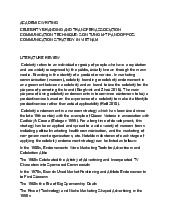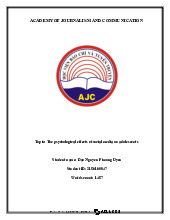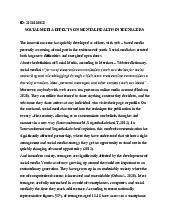













Preview text:
lOMoAR cPSD| 46560390
Banking Academy of Vietnam
International School of Business A business report on
THE TITLE OF THE REPORT
Teacher: Trương Thùy Anh
Student: Nguyễn Thanh Tùng Class: CA12E
Course: Academic Writing Skills Hanoi, 29/2/2024 1 lOMoAR cPSD| 46560390 A report on The Title of the Report by Nguyễn Thanh Tùng Class: CA12E Lecturer: Trương Thùy Anh
Course: Academic Writing Skills
The adoption of "RED BULL STRATOS" By Red Bull GmbH Company I. Introduction II.
The profile of Red Bull GmBh company 2.1. Kind of business
2.2. History development 2.3. Main business
2.4. Vision/mission/Objectives/Core value
2.5. Organizational structure
3. The adoption of strategy “Red Bull Stratos” by Red Bull GmbH company 3.1. Definitions 3.2. Analysis 3.3. Evaluation 4. Conclusion (3279 words) 2 lOMoAR cPSD| 46560390
THE ADOPTION OF "RED BULL STRATOS" BY RED BULL GmbH COMPANY I. Introduction
Marketing is an important factor in five ways: product or service for the client, helping
build brand name, and creating profit for the enterprise, so the company Red Bull GmbH has
done that very well. With the strategy "Red Bull Stratos" to create an event to comprehend
advertising. A successful company, Red Bull GmbH, after this strategy 6 months, sales
revenue increased 7% to 1.6 billion USD in the US market (Mateschitz, 2024) . It has
helped the company build a strong image and associate the brand with adventure, risk, and
breakthrough. This has created curiosity and attracted new customers. In addition, the "Red
Bull Stratos" campaign also generated a lot of advertising content and media events, helping
to increase customer interaction and create new outreach opportunities. Since then, Red Bull's
sales and revenue have likely increased due to consumer interest and support. The present
research provides an overview of Red Bull GmbH and assesses the efficacy of the company's
adopted "Red Bull Stratos" strategy by scrutinising its implementation.
II. The profile of Red Bull GmbH 2.1. Kind of business
Red Bull GmbH, also known as Red Bull, is a global business with headquarters in the
Austria. Redbull’s global headquarters are located at Fuschl am See. Business is the sort of
corporation. These days, RedBull operates in more than 20.000 retail locations and employs
about 161,000 people. The company has made a name for itself across the globe, particularly
with Red Bull, whose revenue climbed by 9% in 2023, from 9.684 billion euros to roughly 10.549 billion euros.
2.2. History of development
In 1987, the energy drink Red Bull was officially introduced to the market, marking a
collaborative venture between Dietrich Mateschitz and Chaleo Yoovidhya. By 1992, the brand
had begun its quest for global dominance, opening its very first European office and thereby
initiating its international expansion. This global stride continued into 1997 when Red Bull
made a significant leap into the US market, thus extending its reach into one of the globe's
most lucrative arenas. The turn of the millennium in 2000 saw Red Bull venturing into the
world of sports sponsorship, supporting a wide array of events from cycling and motor racing
to the adrenaline-pumping world of extreme sports. In a move to cater to healthconscious
consumers, 2005 witnessed the launch of Red Bull Sugarfree, offering the same energizing
effect without the sugar. Further diversifying its portfolio, 2011 marked the establishment of
Red Bull Media House, specializing in the creation and distribution of engaging media
content, from videos to films, showcasing the brand's dynamic engagement with its audience. 3 lOMoAR cPSD| 46560390 2.3. Main business
Operating primarily in the sector of manufacturing and distributing energy drinks, Red Bull
has established itself as a powerhouse not only within the beverage industry but also in the
realms of entertainment, culture, and sports. Beyond its core business, the company has
ventured into sponsoring significant sporting events and organizing vibrant music and cultural
festivals. This diversification reflects Red Bull's commitment to engaging with its audience
beyond the traditional consumer-product relationship, fostering a dynamic and immersive
brand experience that resonates with a broad spectrum of interests and passions. Through
these endeavors, Red Bull has seamlessly integrated its products into the lifestyle of its target
market, making it synonymous with energy, creativity, and high-octane living. : 4 lOMoAR cPSD| 46560390 (Source:)
Red Bull operates globally, establishing itself as a global brand with a widespread presence
across continents, Red Bull Company has a popular sales market in many countries around the
world, including the United States, Europe, Asia, Australia and many other countries. Red
Bull's target market primarily consists of young adults, high-energy consumers from segments
such as students, young professionals, athletes, and enthusiasts of extreme sports. Red Bull
markets its product as a source of instant energy and concentration boost, catering to the needs
of individuals with busy lifestyles who require maintaining alertness and energy throughout
the day. The company also targets individuals involved in contemporary cultural activities like
music, art, and fashion, employing marketing campaigns and sports events to emotionally and
personally connect with this audience. (Source: Statistic)
2.3. Organizational structure:
According to RedBull’s organizational structure, we have an Interactive chart: 5 lOMoAR cPSD| 46560390 (Source: FourWeekMBA)
2.4 Vision, mission and adjective:
Red Bull's "Give You Wings" vision signi 昀椀 es more than just energizing drinks; it
symbolizes empowering individuals to exceed limitations and enhance their performance,
akin to the limitless nature of 昀氀 ight. The mission, focusing on uplifting people and ideas,
underscores Red Bull's commitment to leading the energy drink market through superior
customer service, e 昀케 ciency, and pro 昀椀 tability. This approach not only aims to
invigorate consumers but also to foster innovation and satisfaction within its community. Red
Bull's strategic aspirations include broadening its market presence by venturing into untapped
territories and reaching out to new customer segments. A key focus is on fortifying its brand
identity through innovative marketing, strategic sponsorships, and continuous product
innovation. The company is also keen on diversifying its beverage portfolio, aiming to cater to a
broader audience and stay ahead of evolving trends within the beverage sector. Furthermore,
Red Bull is committed to bolstering its international footprint, tailoring its o 昀昀 erings and
promotional tactics to suit diverse global tastes. Additionally, embracing sustainability and social
responsibility forms a crucial part of its objectives, highlighting Red Bull’s dedication to
environmental stewardship and ethical business practices. 2.5 Core Values:
Red Bull's ethos is deeply rooted in its commitment to innovation, manifesting through
cutting-edge marketing and continuous product innovation, underscoring the importance of
creativity and ingenuity in its operations. The brand embodies performance, not just by 6 lOMoAR cPSD| 46560390
associating with extreme sports but by striving for excellence and setting new standards in
everything it does. Its passion is evident in every facet of its business, from product creation
to supporting athletes and engaging with its audience. Red Bull champions authenticity,
seeking genuine connections and experiences, especially within the adventurous realms it
participates in. At its core, Red Bull harbors an entrepreneurial spirit, born from its founders'
vision, encouraging a culture of risk-taking, innovative thinking, and breaking the
conventional mold to forge new paths in the industry.
III. THE ADOPTION OF "RED BULL STRATOS" BY RED BULL GmbH COMPANY
3.1. Definitions of marketing
The link that exists between companies and prospective clients is known as marketing. A
business will usually take the following measures to encourage the purchase or sale of an item
or service: marketing, selling, and delivering goods to clients or other companies. For
businesses, marketing is like a key that unlocks the door to success. It boosts revenue and
advertises the company. Aside from that, marketing initiatives assist companies in promoting
sustainable development by drawing in and retaining a loyal clientele. ( Forsey, 2022)
A popular tactic in marketing is the "marketing mix," which involves introducing and
promoting goods and services to customers' plans. It encompasses a wide range of topics and
is essential to a thorough advertising strategy. Even though there are now other varieties,
including the 7Ps and 12 Ps of marketing, 4Ps marketing remains the most fundamental. It is
seen as a component of the marketing mix as a whole. This term usually refers to the main
elements or sections of a consumer attraction strategy that promotes products that begin with
the letter P. These elements may include things like: Product, Pricing, Place, and Promotion.
Harvard University advertising professor Neil Borden initially proposed this strategy in the
1950s.The four P's of marketing are still widely used by businesses and marketers today.
3.2 Definition of marketing mix strategy
The marketing mix strategy, also know as the 4Ps of marketing, refers to a set of tactical
tools and actions that a company uses to promote and sell its products or services
3.3 De 昀椀 nition of 4Ps
The 4Ps of marketing, comprising Product, Price, Place, and Promotion, serve as
foundational elements of a marketing strategy. The "Product" aspect focuses on the tangible
goods or services offered, encompassing design, functionality, branding, and packaging
decisions. "Price" relates to determining an optimal price point that reflects production costs,
market competition, and consumer demand, employing strategies such as discounts or
premium pricing. "Place" or distribution ensures the product's availability to consumers,
involving choices around channels, logistics, and retail strategies to effectively reach the
target market. Lastly, "Promotion" covers the communication efforts to highlight the product's
benefits to potential customers, utilizing tools like advertising, public relations, and direct
sales efforts to drive awareness and engagement. 3.4 Analysis:
RedBull has adopted this strategy suc;/cessfully. To be more speci 昀椀 c: 7 lOMoAR cPSD| 46560390 3.4.1 Products:
This initial component pertains to the product or collection of products o 昀昀 ered to
consumers, aimed at ful 昀椀 lling their desires and anticipations.
Red Bull's iconic logo, featuring two confronting bulls against a sunrise, symbolizes strength
and vitality, complemented by the vivid red and yellow colors that evoke excitement. Its
sleek, smaller can design not only stands out for convenience but also signi 昀椀 es quality,
accented by the distinctive blue and silver palette that enhances brand recognition.
Furthermore, Red Bull's formula, rich in taurine, ca 昀昀 eine, and B-vitamins, promises
immediate energy boosts, appealing to those seeking an e 昀昀 ective energy drink option. (Source: powermonsterbull)
The "Red Bull Stratos" campaign has markedly ampli 昀椀 ed brand recognition. By aligning
the Red Bull name with thrilling sports and events, the company has crafted a powerful and
recognizable brand image. This strategic move has not only heightened consumer awareness
but also established Red Bull as a top-of-mind energy drink.
This heightened brand visibility has translated into increased sales volumes, reinforcing Red
Bull's position as a premier energy drink producer. Moreover, the brand has successfully
penetrated new markets, extending its reach into the realms of media and entertainment. 8 lOMoAR cPSD| 46560390
Additionally, the success of their marketing campaigns has fueled innovation within the
company. Red Bull has expanded its product line, introducing new variations of its energy
drink and other related products. This diversi 昀椀 cation meets the evolving needs of
consumers and keeps the brand in the spotlight.
Sales of Red Bull energy drinks in the United States from 2015 to 2023 (in million U.S. dollars) (Source: Statistic.com) 3.4.2. Price:
The marketing mix includes this important element, which shows how much people are
willing to spend on the goods they buy. Value-based pricing was introduced by Nike in an
effort to boost revenue and profitability while acquiring the requisite portion of the worldwide market.
The Red Bull Stratos project significantly improved the brand image of Red Bull, positioning
it as a symbol of adventure and pushing boundaries. This increase in brand value and
enhanced perception justifies Red Bull's premium pricing strategy.
Consumers are often willing to pay more for products associated with an adventurous lifestyle
and outstanding achievements. Through Stratos and similar marketing efforts, Red Bull has
established itself not just as an energy drink but as a symbol of extreme accomplishment. 9 lOMoAR cPSD| 46560390 (Source: powermonsterbull)
In the provided chart, Red Bull's pricing varies depending on the size of the can and is
compared against other brands such as Burn, Monster, and Surge.From this chart, we can
deduce that Red Bull commands a higher price per liter than its competitors like Monster
and Surge. This pricing disparity likely mirrors Red Bull's premium pricing strategy, which
may stem from its strong brand image, e 昀昀 ective marketing campaigns, and broad
brand recognition. This strategy suggests that Red Bull has successfully positioned itself as a
luxury or premium option in the energy drink market, enabling it to set and maintain higher
price points. This premium is not merely a re 昀氀 ection of the cost but rather the
perceived value that the brand o 昀昀 ers, associating itself with an elite lifestyle and high-
octane experiences that resonate with its target demographic. 3.4.3 Place
Red Bull's in 昀氀 uence on the distribution channels, also known as "place" in marketing,
can be seen through its well-established distribution network that ensures its products are
widely available in various retail outlets, convenience stores, supermarkets, and vending
machines globally. The company strategically partners with distributors and retailers to
make its products easily accessible to consumers in urban and rural areas. This extensive
network plays a crucial role in making Red Bull products readily available to consumers at the right place and time. 10 lOMoAR cPSD| 46560390
Furthermore, Red Bull focuses on establishing a strong presence in onpremise locations such
as bars, clubs, and restaurants. By partnering with these establishments, Red Bull ensures
that its products are prominently displayed and readily available for purchase by consumers
looking for an energy boost while socializing or attending events. This strategic placement
helps increase brand visibility and drives impulse purchases among consumers.
In addition to traditional brick-and-mortar retail channels, Red Bull has expanded its
distribution strategy to include online platforms. The company sells its products through its
o 昀케 cial website and e-commerce platforms like Amazon, catering to a wider audience
and meeting the needs of consumers who prefer shopping online for convenience. 3.4.4 Promotion
Media-related activities including public relations, sales promotions, advertising, selling,
sponsorship, direct marketing, and so on are included in the marketing mix. This strategy
seeks to raise consumer awareness of the product and promote purchasing. Additionally,
Nike needs to use this strategy to draw in customers and maintain the reputation of its brand.
Red Bull's "Red Bull Strategies" marketing campaign is a comprehensive and multi-faceted
approach to promoting the brand and its products. The campaign focuses on a number of
key strategies that have been successful in engaging consumers and driving sales.
Sponsorship and Event Marketing, Red Bull is well-known for its sponsorship of extreme
sports events, music festivals, and other highenergy activities. This strategy helps the brand
connect with its target audience of young, active individuals who are looking for an
adrenaline rush. By associating the brand with exciting and adventurous experiences, Red
Bull is able to create a strong emotional connection with consumers.
Content Marketing Red Bull has also invested heavily in creating highquality content that
appeals to its target audience. This includes videos, articles, and social media posts that
showcase extreme sports, music, and other exciting activities. By providing engaging and
shareable content, Red Bull is able to generate buzz around the brand and keep consumers coming back for more.
Red Bull has worked with a number of in 昀氀 uencers and athletes to promote its products.
By partnering with individuals who are respected and admired by its target audience, Red
Bull is able to reach a wider audience and build credibility for the brand.
Red Bull has also been successful in integrating its products into popular culture through
product placement in movies, TV shows, and video games. This strategy helps to keep the
brand top-of-mind for consumers and reinforces its image as a high-energy, adventurous brand. 11 lOMoAR cPSD| 46560390
Overall, Red Bull's "Red Bull Strategies" marketing campaign has been highly e 昀昀 ective in
driving promotional activities and engaging consumers. By focusing on sponsorship, content
marketing, in 昀氀 uencer partnerships, and product placement, Red Bull has been able to
create a strong brand identity and connect with its target audience in a meaningful way. IV. Evaluation
After analysing the way of impleting the certain business strategy on the chose company, the
writer should evaluate the e 昀昀 ectivenes of the business strategy with some evidence which proves its success
The Red Bull Stratos campaign, featuring Austrian daredevil Felix Baumgartner's skydive from
the stratosphere, was more than just a marketing stunt; it was a momentous event that signi
昀椀 cantly boosted Red Bull's brand visibility and engagement across social media
platforms. This daring feat, executed on October 14, 2012, not only tested human limits but
also showcased Red Bull's commitment to pushing the boundaries of what's possible,
aligning perfectly with their brand identity of high-energy and adventure.
The campaign's success was evident in the numbers. On YouTube, the live stream attracted
over 8 million concurrent viewers, setting a new record at the time and contributing to a
massive surge in Red Bull's YouTube subscribers. The day of the jump saw an addition of
87,801 subscribers, leading to a total of 10.5 million subscribers for Red Bull's channel.
Facebook and Twitter also saw remarkable engagement, with the Stratos campaign's
dedicated pages garnering extensive interactions and shares, highlighting the global reach and resonance of the event.
Financially, the campaign had a signi 昀椀 cant impact on Red Bull's sales and brand metrics.
Red Bull invested over $30 million into the Stratos project, which resulted in a monumental
increase in brand awareness and sales following the event. According to a study by Millward
Brown, brand recall increased by 69%, and brand preference by 77%. Moreover, the
campaign generated over 5 billion media appearances worldwide, over 50 million YouTube
views, an uptick in online brand searches, and increased sales in retail stores. This outcome
solidi 昀椀 ed the Stratos campaign as Red Bull's most successful marketing endeavor to
date, showcasing the power of innovative, risk-taking marketing strategies.
The Red Bull Stratos campaign is a prime example of how audacious and well-executed
marketing e 昀昀 orts can transcend traditional advertising, leaving a lasting impression on
the brand's identity and signi 昀椀 cantly boosting both social media engagement and 昀椀 nancial performance. 12 lOMoAR cPSD| 46560390 V.Conclusion
To sum up, the Red Bull Stratos campaign exempli 昀椀 es the remarkable impact of
innovative marketing strategies that push the boundaries of conventional advertising. By
sponsoring Felix Baumgartner's stratospheric skydive, Red Bull not only broke physical
barriers but also set new benchmarks in digital engagement and brand promotion. This
campaign transcended mere advertising, becoming a global phenomenon that signi 昀椀
cantly elevated Red Bull's brand visibility, social media reach, and ultimately, its sales and market position.
The strategic execution of the Stratos project, including the live stream that captivated
millions worldwide, demonstrates the power of content that resonates on a deep, emotional
level with audiences. In summary, Red Bull Stratos was more than a marketing campaign; it
was a testament to the power of bold, innovative thinking in capturing the global
imagination, driving brand growth, and establishing a lasting legacy in the marketing world.
Through this endeavor, Red Bull showcased the e 昀昀 ectiveness of leveraging high-stakes
adventure and cutting-edge technology to achieve unparalleled engagement and brand loyalty. References
Associated Press. (2014, April 02). Baumgartner's Capsule Going on View in D.C. Retrieved
from https://www.nbcwashington.com/news/local/Supersonic-Skydivers-Capsule-Going on-View-in-DC-253343791.html
Athletes. (2018). Retrieved from https://www.redbull.com/us-en/athletes Ayyar,
R. (2015). Red Bull on Content Marketing.
Retrieved from https://www.targetmarketingmag.com/article/case-study-red-bull- marketing/all/
Chapple, S. (2013, August 16). The Value of PR Stunts. Retrieved from
http://www.cision.ca/trends/the-value-of-pr-stunts/
Chun, J. (2012, October 15). Red Bull Stratos May Change Future Of Marketing. Retrieved
https://www.huffingtonpost.com/2012/10/15/red-bull-stratos
Collier, M. (2018, July 16). Red Bull Creates Better Content Than You Do, Here's How They
It. Retrieved from http://www.mackcollier.com/red-bull-content-marketing/ Col.
Joe Kittinger. (2012). Retrieved from http://www.redbullstratos.com/the-team/joe kittinger/index.html
Hawthorne Strategy Group. (n.d.). Red Bull. Retrieved from
https://www.hawthornestrategy.com/case_study/red-bull/
MarketLine. (2018, March 19). Red Bull GmbH: Company profile. Retrieved from Advantage database. 13 lOMoAR cPSD| 46560390
Mission History. (2012). Retrieved from http://www.redbullstratos.com/the- history/
Nudd, T. (2012, October 15). Red Bull Triumphs With Baumgartner Jump by Getting Out of the
Way. Retrieved from https://www.adweek.com/creativity/red-bull-
baumgartner-jump-getting-out-way-144464/ Red Bull Stratos
Content Pool. (n.d.). Retrieved from
https://www.redbullcontentpool.com/redbullstratos
Red Bull Stratos' Contribution to Science. (2012, October 29). Retrieved from
https://www.redbull.com/us-en/red-bull-stratos-contribution-toscience
Sampiero, J. (2013, February 15). Red Bull Stratos: 8 World Records. Retrieved from
https://www.redbull.com/us-en/one-jump-eight-records-scienti 昀椀 cachievement
Skene, K. (2014, March 14). A PR Case Study: Red Bull Stratos. Retrieved from
https://www.newsgeneration.com/2014/03/14/pr-case-study-redbull-stratos/ 14




